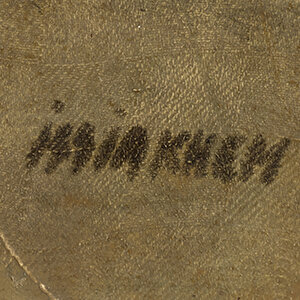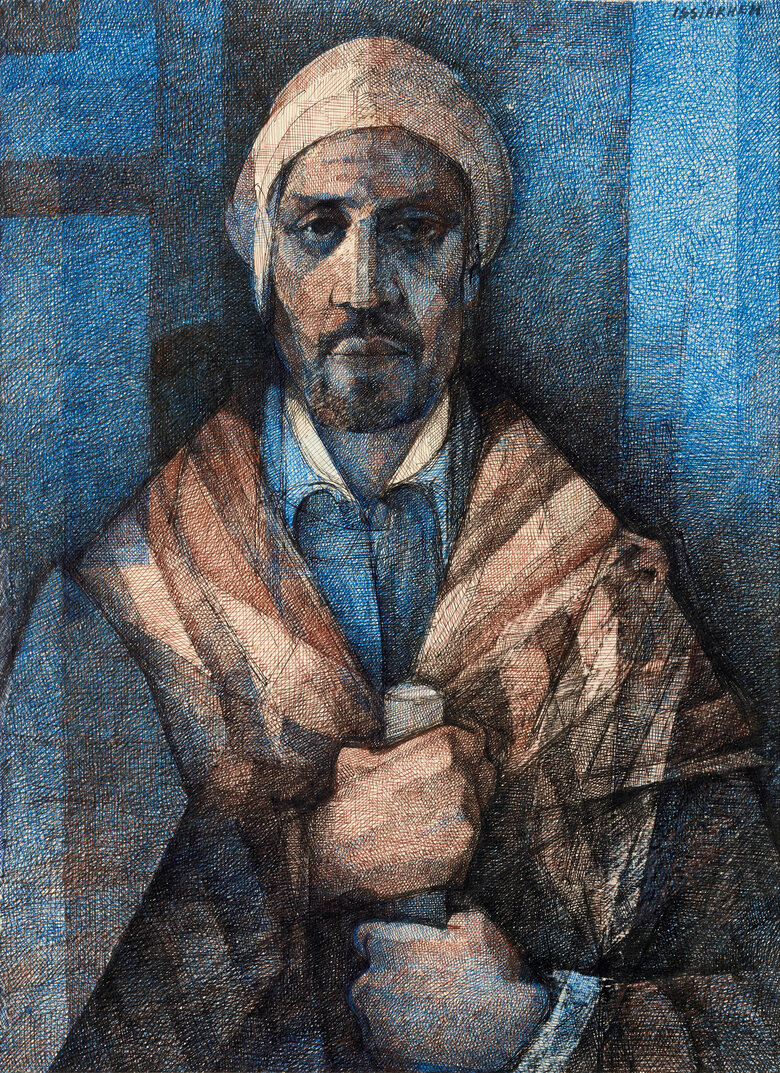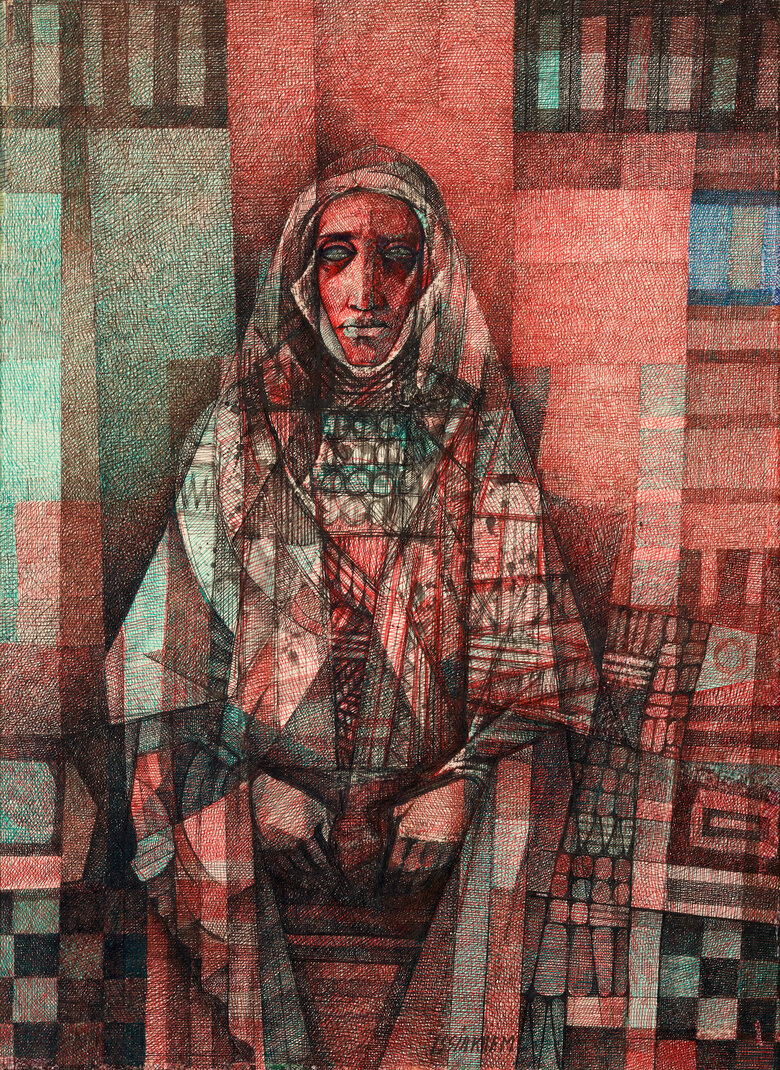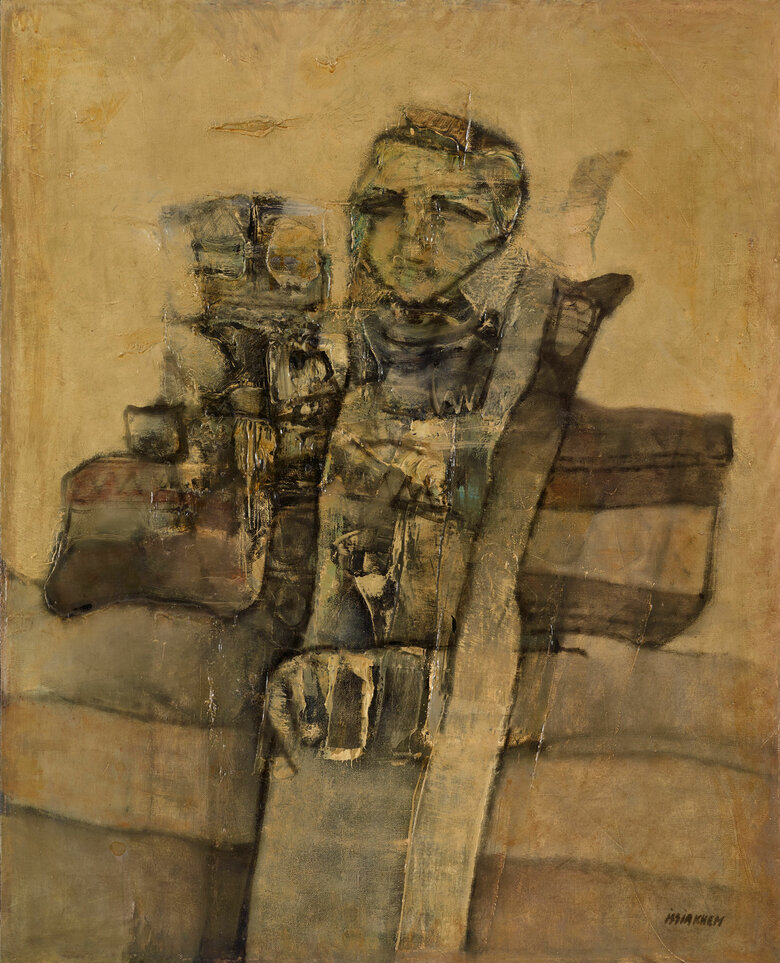Written by Arthur Debsi Born preterm in 1928 in a small village called Taboudoucht in the Kabylia region, Mohamed Issiakhem moved to Relizane with his father in 1931, who sought to find a better...


MOHAMED ISSIAKHEM, Algeria (1928 - 1985)
Bio
Written by Arthur Debsi
Born preterm in 1928 in a small village called Taboudoucht in the Kabylia region, Mohamed Issiakhem moved to Relizane with his father in 1931, who sought to find a better future for his family. During the WWII, Algeria served as a rear base for Free France against the occupation of Nazi Germany. In Relizane, a school had been transformed into a military camp, where kids were playing. On July 27th, 1943, the young Issiakhem grabbed a grenade from a crate, which exploded in his hands, resulting in the death of his sisters Saïda, and Yasmine, and his nephew Tarik. This tragic accident had a strong impact on the relationship between Mohamed Issiakhem, and his mother to the extent that he had to leave the family house. As a matter of fact, in Kabylia family culture, women pass on knowledge to their daughters, and prepare their sons to follow the path of their fathers[1]. Since Issiakhem got his arm amputated, he couldn’t fulfill the expectations of the mother.
In 1947, Mohamed Issiakhem consequently took the train to go to Algiers, where he stumbled upon the plaque of the Société des Beaux-Arts, while having a walk in the Place Bugeaud, now the Place de l’Émir Abdelkader. The Société des Beaux-Arts was founded in 1851 by Laurent Laperlier (1805-1878), and provided courses of drawing, and painting for free. Issiakhem started his training there. After 1945, the Algerian artists – called ‘indigenous’ – officially got the status of ‘Muslim French’, which allowed them to register at the École des Beaux-Arts in Algiers. Four years after this administrative change, Mohamed Issiakhem enrolled in the establishment, and studied under the supervision of the Algerian artist Mohammed Racim (1896-1975). The latter taught the student traditional arts, such as the miniatures, and Western academic painting. Issiakhem also attended courses of Art History, provided by the French art historian Jean Alazard (1887-1960); and engraving classes with Jean-Eugène Bersier (1895-1978). The curriculum was very rich, and complete as it included landscape painting, the study of anatomy, painting, and drawing from live models, and feminine nudes. From 1944 to 1947, France established new rules, which reformed the status of Muslim Algerian people, enabling them to circulate more easily between their country, and continental France[2]. Since then, many Algerian artists were able to emigrate, and escape from the hard conditions of living in their homeland.
In 1953, Mohamed Issiakhem traveled to France, where he completed his education at the École Nationale Supérieure des Beaux-Arts in Paris for free, because he was physically handicapped. In 1959, he left France for the German Democratic Republic, where he briefly resided in Leipzig, and had a solo exhibition at Galerie Donilstraz. In 1962, he joined the Algerian writer, and friend Kateb Yacine (1929-1989), with whom he went back to Algeria. There, he became an illustrator for the daily newspaper called Alger Républicain until 1964. While painting, Issiakhem never stop working as an illustrator, and he is especially known to have illustrated the Algerian banknotes, and stamps from 1965 to 1982. He also worked in education, being appointed as a teacher at the École des Beaux-Arts in Algiers, prior to moving to Oran, where he directed the École des Beaux-Arts. In 1971, Issiakhem became teacher of graphic art at the École Polytechnique d’Architecture et d’Urbanisme in Algiers.
In the 1970s, Mohamed Issiakhem produced works, whose the palette of colors was gray, and white. This was called the ‘white period’ of the artist. As a matter of fact, Issiakhem faced a shortage of paint tubes, and consequently used house paint from Société Nationale des Industries Chimiques, while waiting for his friends to bring him paint tubes from France[3].
Since the invasion of Algiers in 1830 by the French troops, art was put to the service of the colonialist process in the sense that it showed the cultural superiority of France. A superiority, and a refinement, that the École des Beaux-Arts in Algiers, created in 1920 by the French government, highly promoted, through its courses on Orientalist, and neo-classical movements. In France, Mohamed Issiakhem progressively detached himself from the academic teaching, that he received at the École Nationale Supérieure des Beaux-Arts in Paris, thinking that he had already learned everything in Algeria[4]. In the 1950s, he moved towards abstract art, that he discovered in the French capital city, through the artworks of Jean Dubuffet (1901-1985), and art brut. Against a backdrop of a political crisis, leading to the Algeria war in 1954; the Algerian artists in France, including Mohammed Khadda (1930-1991), and Abdallah Benanteur (1931-2017), started their reflections, and experimentations on the foundation of modern Algerian art. In his program, Mohamed Issiakhem insisted on the fact that the indigenous artist lent themselves to a wide range of artistic influences, according to the rich artistic, and cultural past of Algeria, and this would form his authenticity. He wrote: ‘From works of Berber craftmanship steeped in the myriad currents of the ancient African world to the most recent figurative or abstract paintings, we are living the history of multiple influences: Carthaginian, Roman, Byzantine, Arab, and French’[5]. Hence, this historical factor would help Algerian artists to free themselves from the colonial hold, which had conditioned them since the beginning of their careers. To Issiakhem, the Algerian artist had to be free in his creation, and simultaneously respond to the social aspirations of his people.
Throughout his artistic journey, Mohamed Issiakhem demonstrated his mastery in working on the diverse genres of painting, and styles. However, he specifically affirmed himself as an accomplished portraitist, who aimed to convey the personality of the sitter, rather than the physical appearance. Part of the Dalloul Art Foundation’s collection, a series of paintings manifests the talent of the artist, who captured the portraits of different figures, through a remarkable abstract technique. In this series, he produced the portraits of anonymous people, employing abstracted forms, countered with thick black brushstrokes, and applying a palette of earthy colors such as in Cette Oblique (1983). On the other hand, he also portrayed more identifiable people seen in the two non-dated works entitled, Homme, and Femme. Using ink, and pencil, Issiakhem produced a very dynamic drawing, with straight, and thin lines. He respectively used the blue color for the man’s portrait, while he applied the red color for the woman’s portrait. With a frontal view, and a lack of perspective, he depicted a man, and a woman, who both stare at the spectator with deep eyes. They both seem to belong to the traditional Algerian society, as indicated by their garments. The man wears the djellaba with the burnous, a traditional wool coat, and a turban; whereas the woman is wearing a long veil with a dress, and some jewelry around her neck. In his paintings, Mohamed Issiakhem always showed his interest in illustrating ordinary people – especially women[6], workers, etc. He wanted to render their personal emotions, and faithfully interpret their lives. In the artistic tradition, the genre of portrait was originally reserved for the representation of important people, from the social elite, and the aristocracy. Here, by portraying two normal people, standing straight, and proud; Issiakhem reconsidered their social status, and elevated their images in order to place them in the history of modern Algeria.
Mohamed Issiakhem is part of this generations of artists, who lived the historical transition of Algeria, from the French occupation to the independent country. His artworks revealed the experimental move, through which Algerian modern art established in the 1950s. But, even in this particular political context, Issiakhem never chose propaganda in favor of the independent movement. He preferred to focus on the human being, and revealed his suffering, misery, and sadness, as the illustration of a social reality.
Mohamed Issiakhem passed away in 1985.
Sources
Ali, Wijdan. Modern Islamic Art: Development and Continuity. Gainesville, USA: University Press of Florida, 1997.
Bouabdellah, Malika Dorbani, Inal Djaâfar, and Boualem Hammouche. M'hamed Issiakhem à La mémoire De ... Alger, Algeria: Musée national d'art moderne et contemporain, 2010.
Dorbani, Malika. ‘Les Prémices De La Peinture De La Modernité Et Contemporaine En Algérie’ February 5, 2019. https://www.persee.fr/doc/horma_0984-2616_2002_num_47_1_2075.
Eigner, Saeb. Art of the Middle-East, Modern and Contemporary Art of the Arab World and Iran. London, UK: Merell Publishers Limited, 2011.
Gillet, Fanny. ‘Les Artistes Algériens à Paris Pendant La Guerre D'Algérie: Entre Quête De Reconnaissance Et Construction D'un Discours Esthétique Moderne’, 2011. De La Guerre Dans l'Art, De l'Art Dans La Guerre, Revue Textuel, Paris 7, no. 63 (2011): 161–73.
Lenssen, Anneka, A. Rogers, Sarah, and Shabout, Nada. Modern Art in the Arab World, Primary Documents. New York, USA: The Museum of Modern Art, 2018.
Pouillon, François. “La Peinture Monumentale En Algérie: Un Art Pédagogique.” Cahiers d'Études africaines. Persée - Portail des revues scientifiques en SHS, March 16, 2016. https://www.persee.fr/doc/cea_0008-0055_1996_num_36_141_2008.
“Algerian War.” Encyclopædia Britannica. Encyclopædia Britannica, inc. Accessed November 16, 2020. https://www.britannica.com/event/Algerian-War.
[1] Bouabdellah, Malika Dorbani, Inal Djaâfar, and Boualem Hammouche. M'hamed Issiakhem à La mémoire De ... Alger, Algeria: Musée national d'art moderne et contemporain, 2010. [P.28]
[2] Gillet, Fanny. ‘Les Artistes Algériens à Paris Pendant La Guerre D'Algérie: Entre Quête De Reconnaissance Et Construction D'un Discours Esthétique Moderne’, 2011. De La Guerre Dans l'Art, De l'Art Dans La Guerre, Revue Textuel, Paris 7, no. 63 (2011): 161–73.
[3] Bouabdellah, Malika Dorbani, Inal Djaâfar, and Boualem Hammouche. M'hamed Issiakhem à La mémoire De ... Alger, Algeria: Musée national d'art moderne et contemporain, 2010. [P.32]
[4] Dorbani, Malika. ‘Les Prémices De La Peinture De La Modernité Et Contemporaine En Algérie’ February 5, 2019. https://www.persee.fr/doc/horma_0984-2616_2002_num_47_1_2075. [P.167]
[5] M’hamed Issiakhem, ‘La Peinture’, La Nouvelle Critique, no.112, special issue on ‘La Culture Algérienne’ (January 1960): 138-39; repr. In M’Hamed Isskiakhem (Algiers: Éditions Bouchène, 1988). Translated from French by Teresa Villa-Ignacio in Lenssen, Anneka, A. Rogers, Sarah, and Shabout, Nada. Modern Art in the Arab World, Primary Documents. New York, USA: The Museum of Modern Art, 2018. [P.197]
[6] Bouabdellah, Malika Dorbani, Inal Djaâfar, and Boualem Hammouche. M'hamed Issiakhem à La mémoire De ... Alger, Algeria: Musée national d'art moderne et contemporain, 2010. [P.80]
CV
Selected Solo Exhibitions
2018
I Colori dell’amicizia, Issiakhem: mano monca, immaginario in fiamme, Ex Fornace Gola, Milano, Italy
2015
Issiakhem à Relizane, Maison de la Culture, Relizane, Algeria
2010
M’hamed Issiakhem, Musée Public National d’Art Moderne et Contemporain d’Alger, Algiers, Algeria
Hommage à M’hamed Issiakhem, University of Béjaïa, Béjaïa, Algeria
1986
Issiakhem, Rétrospective II, Musée National des Beaux-Arts d’Alger, Algiers, Algeria
M’hamed Issiakhem, Office Riad El-Feth, Algiers, Algeria
1959
Donilstraz Gallery, Leipzig, German Democratic Republic
Selected Group Exhibitions
2024
Arab Presences: Modern Art And Decolonisation: Paris 1908-1988, Musée d'Art Moderne de Paris, Paris, France
2022
Algérie mon amour, Artistes de la fraternité algérienne 1953-2021, Institut du Monde Arabe, Paris, France
2021
Memory Sews Together Events that hadn’t Previously Met, Sharjah Art Museum, Sharjah, United Arab Emirates
Algerian Modernism, Elmarsa, Al Quoz, Dubai,United Arab Emirates
2020
Artistes de la Fraternité Algérienne 1963-2020, Centre Culturel Algérien, Paris, France
2018
A Century in Flux, Highlights from the Barjeel Art Foundation, Sharjah Art Museum, Sharjah, United Arab Emirates
2016
The Short Century, Sharjah Museum, Sharjah, United Arab Emirates
2015
Les Collections du Musée, Musée Public National d’Art Moderne et Contemporain d’Alger, Algiers, Algeria
2014
Sky Over the East, Emirates Palace, Abu Dhabi, United Arab Emirates
2012
50 Années d’Art Algérien, Musée National des Beaux-Arts d’Alger, Algiers, Algeria
2008
Les Artistes Internationaux et la Révolution Algérienne, Musée Public National d’Art Moderne et Contemporain d’Alger, Algiers, Algeria
2007
Art Contemporain Arabe, Palais de la culture Moufdi-Zakaria, Algiers, Algeria
2003
Le XXème siècle dans l’art algérien, L’Orangerie du Sénat, Paris, France
M’Hamed Issiakhem et Kateb Yacine, Peintures, dessins et correspondance, Palais de l’UNESCO, Paris, France
1987
Algérie, Expressions multiples, Musée National des Arts d’Afrique et d’Océanie, Paris, France
1964
Peintres Algériens, Musée des Arts Décoratifs, Paris, France
1963
Peintres Algériens, Musée National des Beaux-Arts d’Alger, Algiers, Algeria
1955
International Festival for Youth and Students, Warsaw, Poland
1951
André Maurice, Paris, France
1949
Galerie Carnot, Algiers, Algeria
Collections
Institut du Monde Arabe, Paris, France
Musée National Cirta, Constantine, Algeria
Musée Public National d’Art Moderne et Contemporain d’Alger, Algiers, Algeria
Musée National des Beaux-Arts d’Alger, Algiers, Algeria
Musée National Nasr Eddine Dinet, Bou Saada, Algeria
The Barjeel Art Foundation, Sharjah, United Arab Emirates
The Ramzi and Saeda Dalloul Art Foundation, Beirut, Lebanon
Press
فنان جزائري رائد في الذكرى الثالثة لرحيله . محمد خدة _ آثار أقدام على رمال الطفولة ... .pdf
تسليم لوحة فنية لإسياخم إلى المتحف الوطني للفنون الجميلة بالعاصمة الإذاعة الجزائرية.pdf
بورتريه _ امحمد اسياخم، عبقرية برزت من عمق الالم نوافذ ثقافية.pdf
أمحمد إسياخم صاحب الذراع المبتورة في أكبر معرض له بالجزائر.pdf
غليزان_افتتاح فعاليات الأيام المخصصة للفنان التشكيلي محمد إسياخم نوافذ ثقافية.pdf
M_hamed Issiakhem, un génie forgé dans la douleur (PHOTOS).pdf
جميلة قابلة اسياخم لنوافذ ثقافية_ظروف تنظيم الأيام التكريمية للراحل اسياخم كانت صعبة نوافذ ثقافية.pdf
جزايرس _ محمد إسياخم..رسام جزائري تغنى بالموت لأنه يحمل في أعماقه سر الحياة.pdf
MOHAMED ISSIAKHEM Artwork
Become a Member
Join us in our endless discovery of modern and contemporary Arab art
Become a Member
Get updates from DAF
Follow Artists
Save your favourite Artworks
Share your perspectives on Artworks
Be part of our community
It's Free!
We value your privacy
TermsCookiesPrivacy Policies
Become a Member
Get updates from DAF
Follow Artists
Save your favourite Artworks
Share your perspectives on Artworks
Be part of our community
It's Free!
We value your privacy
TermsCookiesPrivacy Policies
Become a Member
Get updates from DAF
Follow Artists
Save your favourite Artworks
Share your perspectives on Artworks
Be part of our community
It's Free!
We value your privacy
TermsCookiesPrivacy Policies
Welcome to the Dalloul Art Foundation
Thank you for joining our community
If you have entered your email to become a member of the Dalloul Art Foundation, please click the button below to confirm your email and agree to our Terms, Cookie & Privacy policies.
We value your privacy, see how
Become a Member
Get updates from DAF
Follow Artists
Save your favourite Artworks
Share your perspectives on Artworks
Be part of our community
It's Free!
We value your privacy
TermsCookiesPrivacy Policies










